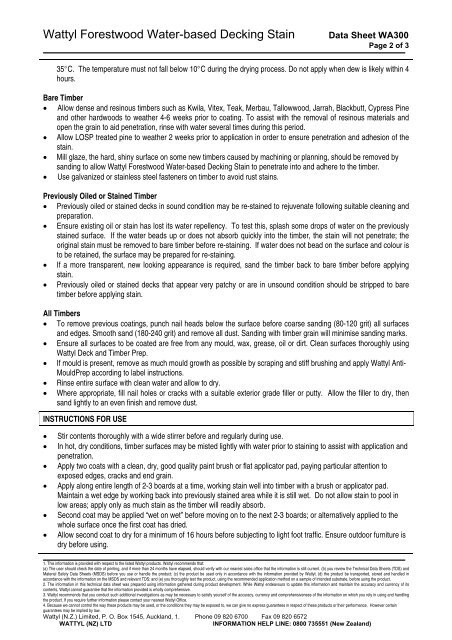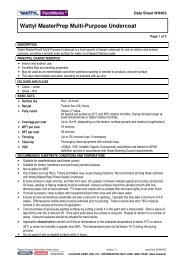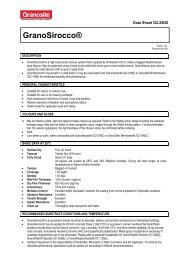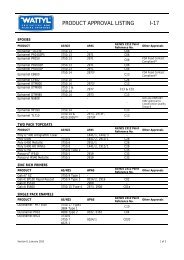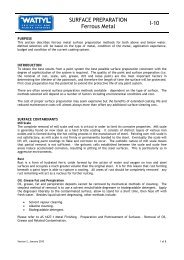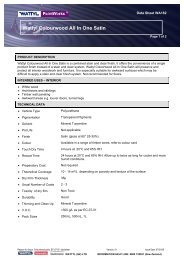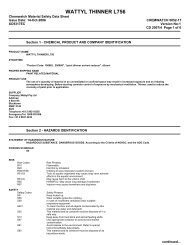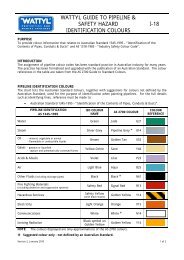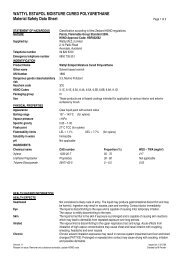Wattyl Forestwood Water-based Decking Stain
Wattyl Forestwood Water-based Decking Stain
Wattyl Forestwood Water-based Decking Stain
Create successful ePaper yourself
Turn your PDF publications into a flip-book with our unique Google optimized e-Paper software.
<strong>Wattyl</strong> <strong>Forestwood</strong> <strong>Water</strong>-<strong>based</strong> <strong>Decking</strong> <strong>Stain</strong>Data Sheet WA300Page 2 of 335°C. The temperature must not fall below 10°C during the drying process. Do not apply when dew is likely within 4hours.Bare Timber• Allow dense and resinous timbers such as Kwila, Vitex, Teak, Merbau, Tallowwood, Jarrah, Blackbutt, Cypress Pineand other hardwoods to weather 4-6 weeks prior to coating. To assist with the removal of resinous materials andopen the grain to aid penetration, rinse with water several times during this period.• Allow LOSP treated pine to weather 2 weeks prior to application in order to ensure penetration and adhesion of thestain.• Mill glaze, the hard, shiny surface on some new timbers caused by machining or planning, should be removed bysanding to allow <strong>Wattyl</strong> <strong>Forestwood</strong> <strong>Water</strong>-<strong>based</strong> <strong>Decking</strong> <strong>Stain</strong> to penetrate into and adhere to the timber.• Use galvanized or stainless steel fasteners on timber to avoid rust stains.Previously Oiled or <strong>Stain</strong>ed Timber• Previously oiled or stained decks in sound condition may be re-stained to rejuvenate following suitable cleaning andpreparation.• Ensure existing oil or stain has lost its water repellency. To test this, splash some drops of water on the previouslystained surface. If the water beads up or does not absorb quickly into the timber, the stain will not penetrate; theoriginal stain must be removed to bare timber before re-staining. If water does not bead on the surface and colour isto be retained, the surface may be prepared for re-staining.• If a more transparent, new looking appearance is required, sand the timber back to bare timber before applyingstain.• Previously oiled or stained decks that appear very patchy or are in unsound condition should be stripped to baretimber before applying stain.All Timbers• To remove previous coatings, punch nail heads below the surface before coarse sanding (80-120 grit) all surfacesand edges. Smooth sand (180-240 grit) and remove all dust. Sanding with timber grain will minimise sanding marks.• Ensure all surfaces to be coated are free from any mould, wax, grease, oil or dirt. Clean surfaces thoroughly using<strong>Wattyl</strong> Deck and Timber Prep.• If mould is present, remove as much mould growth as possible by scraping and stiff brushing and apply <strong>Wattyl</strong> Anti-MouldPrep according to label instructions.• Rinse entire surface with clean water and allow to dry.• Where appropriate, fill nail holes or cracks with a suitable exterior grade filler or putty. Allow the filler to dry, thensand lightly to an even finish and remove dust.INSTRUCTIONS FOR USE• Stir contents thoroughly with a wide stirrer before and regularly during use.• In hot, dry conditions, timber surfaces may be misted lightly with water prior to staining to assist with application andpenetration.• Apply two coats with a clean, dry, good quality paint brush or flat applicator pad, paying particular attention toexposed edges, cracks and end grain.• Apply along entire length of 2-3 boards at a time, working stain well into timber with a brush or applicator pad.Maintain a wet edge by working back into previously stained area while it is still wet. Do not allow stain to pool inlow areas; apply only as much stain as the timber will readily absorb.• Second coat may be applied “wet on wet” before moving on to the next 2-3 boards; or alternatively applied to thewhole surface once the first coat has dried.• Allow second coat to dry for a minimum of 16 hours before subjecting to light foot traffic. Ensure outdoor furniture isdry before using.1. This information is provided with respect to the listed <strong>Wattyl</strong> products. <strong>Wattyl</strong> recommends that:(a) The user should check the date of printing, and if more than 24 months have elapsed, should verify with our nearest sales office that the information is still current. (b) you review the Technical Data Sheets (TDS) andMaterial Safety Data Sheets (MSDS) before you use or handle the product; (c) the product be used only in accordance with the information provided by <strong>Wattyl</strong>; (d) the product be transported, stored and handled inaccordance with the information on the MSDS and relevant TDS; and (e) you thoroughly test the product, using the recommended application method on a sample of intended substrate, before using the product.2. The information in this technical data sheet was prepared using information gathered during product development. While <strong>Wattyl</strong> endeavours to update this information and maintain the accuracy and currency of itscontents, <strong>Wattyl</strong> cannot guarantee that the information provided is wholly comprehensive.3. <strong>Wattyl</strong> recommends that you conduct such additional investigations as may be necessary to satisfy yourself of the accuracy, currency and comprehensiveness of the information on which you rely in using and handlingthe product. If you require further information please contact your nearest <strong>Wattyl</strong> Office.4. Because we cannot control the way these products may be used, or the conditions they may be exposed to, we can give no express guarantees in respect of these products or their performance. However certainguarantees may be implied by law.<strong>Wattyl</strong> (N.Z.) Limited, P. O. Box 1545, Auckland, 1. Phone 09 820 6700 Fax 09 820 6572WATTYL (NZ) LTDINFORMATION HELP LINE: 0800 735551 (New Zealand)


